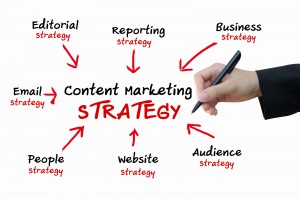 In part one we looked at what content marketing is, why recruiters and HR folk should get involved, and how to build a content marketing strategy that ensures you’re successful.
In part one we looked at what content marketing is, why recruiters and HR folk should get involved, and how to build a content marketing strategy that ensures you’re successful.
Going from strategizing to actually writing content can be daunting though, and it can be difficult to know where to start.
Not to worry. In this part of our guide we look at actually writing top-tier content – sharing tips, tricks, tools and overarching best practices that will help turn even the most reluctant recruiter into a budding wordsmith.
Here goes. For the best, free recruiting management system – use Recruiteze! Click here to recruit easier!
Articles, Infographics and More
Articles are great – they’re informative, narrative, and give you a chance to really develop your voice and point of view, but they’re far from the only type of content out there.
A more varied content mix can be a great way to increase engagement, and can save a lot of time compared to writing an article. Plus, once you’ve written one great article, you can re-purpose it a multitude of ways – hitting your content goals without having to constantly generate new ideas.
Here are ten other types of content to consider.
1 – Videos
Videos used to be the sole domain of the professional filmmaker, but it’s much more accessible now everyone and his brother owns a smartphone. Try making a ‘Recruitment Tip of the Day’ video, or film your team night out to show potential new hires how much fun your office is.
2 – Photos
Visual content gets 94% more total views than simple text content – need I say more? Uploading pictures is quick, easy, and the benefits are clear. Get on it!
3 – Gifs
Photos’ more frivolous older brother, a gif can be a funny, quick way to express your brand personality. Try making them for free with Makeagif.
4 – Slideshare
Creating a Slideshare presentation is a simple step-by-step process, and proven to work really well. You could make a Slideshare detailing your hiring process, for example.
5 – Infographics
A super popular form of content, infographics can feel intimidating to create if you’re not a designer. They needn’t be though – there are loads of tools to make the process simple, and the rewards and well worth it.
6 – Quizzes
Quick, easy, slightly trivial but highly engaging – that’s the quiz. A great way to drive engagement. PollMaker is quick and easy.
7 – Interviews
Think industry influencers, key figures in your company, HR leaders – anything that potential candidates would find interesting and relevant. Post as audio, video or text, or re-purpose as a Slideshare, or an infographic. You get the picture – once you’ve got it, milk it.
8 – Original Research
If you have the resources, collecting and publishing research can pay dividends in terms of building your reputation and credibility.
9 – E-Books
Although an e-book takes time, it can be a fantastic way to give comprehensive information about a topic and assert your company as a thought-leader. Plus, you can collect email addresses from people who download it, and then feed them into and nurture them through your CRM. Creating downloadable content has really tangible benefits in terms of lead generation.
10 – Case Studies
Creating a case study allows you to assert your value without seeming overly self-promotional, making them a powerful attraction tool. Recruiters could construct a case study of a candidate they’ve helped, for example, while HR leaders might create a case study of a new hire in their first week on the job.
Actually writing articles is likely the meat and veg of your strategy though, so let’s look at some writing best practices.
Writing Awesome Content
 “I’m not a writer”. “I can’t write”. “I failed English at college”. Get those thoughts out of your head. Anyone can write – you just need to know some of the best practices.
“I’m not a writer”. “I can’t write”. “I failed English at college”. Get those thoughts out of your head. Anyone can write – you just need to know some of the best practices.
Headlines
Your headline is one of the most important parts of your article, and will determine whether people read your content at all.
It’s more of a science than an art, and there’s research to tell us exactly what makes a clickable headline.
Focus on the benefit – Tell readers WHY they should read on
Make them curious – Intrigue them
Stand out – Grab their attention instantly
Be direct – Single them out; refer to them as ‘you’
Don’t be misleading – Make it clear from the title what to expect reading on
Be simple – Don’t use complicated words when a simple one will do
Ask a question – Challenging the reader with a rhetorical question works well
Imply urgency – Prompt people to read on, and read on now
Shorter is better – 65 characters is the limit for Google search results
Make it sound easy – Simple tips, hassle-free method – you get the picture
Use keywords – Get your primary keyword into the title for SEO purposes
Use interesting adjectives – Stand out from the crowd and grab attention
Throw in a statistic or number – Odd is better than even, apparently
‘Good writer’ or not, high-performing headlines have been proven over and over to rely on features from this list. If you’re still stuck, try some of these headline templates to get the creative juices flowing.
 Know How People Read
Know How People Read
People read differently on the web. They don’t read thoroughly – they skim.
Maybe that sounds obvious – I mean, we all do it – but it’s the single most important thing to know about creating great content. Bear that in mind constantly.
Summarize In Your Intro
Heatmapping studies have shown that people will read (actually read, as opposed to skim) your intro. In other words, if you don’t use your intro to tell them what the article is about and why they should care, you’ve lost them.
Reverse everything you learned in college English, basically – conclude first, then build your argument.
Don’t Digress
Conveying complicated ideas in content rarely works well. Online, people want short, simple, practical tips – not verbose personal anecdotes and lengthy narrative. Get to the point, or you’ll lose your reader.
Break It Up
Everything ties back into how people read. Keep your content simple and easy to scan by breaking the text up. Short paragraphs, headings, sub-headings, bullet points, lists-within-lists – do anything you can to make your text jump out.
Active not Passive
It’s the difference between ‘the cat sat on the mat’ and ‘the mat was being sat on by the cat’. Classic grammar lesson. Avoid the passive voice – it’s longer, less engaging and less impactful.
Length
Longer content is more shareable, because it gives you more space to give really comprehensive details about a topic. Less than 500 words and you risk Google refusing to rank you.
There’s no real consensus on the ideal length, but most advice falls between 1000 and 1500. (This piece gives more detail, if you’re interested in the analysis).
Be Visual
Articles with images get 94% more views – enough said. Include images at the top, and throughout to break up your text.
Link Out
Linking out to other sources gives your own content credibility, both in the eyes of the search engine and for the reader. Only link to good content though – linking to poor content has a knock-on impact on your own credibility.
Don’t Plagiarize
Aside from the obvious moral problem with plagiarism, it’s also a problem in terms of your search ranking, as Google penalizes any sites that have copied copy. Use a tool like Copyscape or SmallSeo to check that your work is 100% unique.
Include Keywords, But Don’t Keyword Stuff
Keywords tell Google what your content is about, so the search engine can rank it for certain relevant terms when users search. You need to include enough of those terms that Google easily knows what topic you cover, but not so many that Google thinks you’re trying to play the system.
If that sounds vague, it’s because it is. Whatever anyone tells you, no one knows much more than that – the algorithms Google uses are a closely guarded secret, and they change regularly.
The guiding principle is this: bear your keywords in mind but write naturally, and always write high quality content. If you’re doing that last one right, everything else will follow.
If In Doubt, Make A List
If constructing a narrative is what you find daunting, then don’t. You don’t need to write a masterpiece, and short n’ snappy is both easier to read and easier to write.
A list post is super easy. You’re already an expert in your field, so thinking of ten, five, even just three, tips about your niche isn’t a big ask. It means you avoid having to string ideas together, and you’ll find the post will almost write itself.
Try things like, ’10 Tips for Candidates in The Interview Room’; ’7 Things Hiring Managers Hate To See’; ‘7 Mistakes I See Every Day In Your CV’ – the possibilities really are endless.
Get Savvy with Tools
 You wouldn’t try and recruit without online recruitment software, so why try and write without online writing tools?
You wouldn’t try and recruit without online recruitment software, so why try and write without online writing tools?
There are some great free ones out there, to help whip your content into shape and make the process just that little bit easier. My personal favorite is Hemingway, an online app that highlights areas you could improve, concluding passive/active voice and word choice. Grammarly is worth checking out too.
Writing killer content is much easier than it seems, and there’s been so much research done that it’s often as simple as following some well-established best practices.
Saying that, the most important takeaway from this piece is to write high quality content. Think about the problems your readers have and use your expert knowledge to help them solve those problems – when you do that right, that’s when you see the real benefits of content marketing.
Candidates will see you as a credible, knowledgeable source, your brand awareness will skyrocket, your positive reputation will snowball, and you’ll soon have a steady stream of inbound candidate leads to choose from. With the market becoming increasingly talent-tight, that gives you a concrete competitive edge.
Writing great content isn’t the end of the story though – without promotion, content marketing is nothing but a waste of time. Wait for Part 3 for practical advice on the final part of the content marketing mix: posting and promoting your content.
What Is The Best Free Recruiting Management System? Recruiteze!
Are you looking for the best technology that can help with your recruiting needs? Do you utilize job boards or have access to a free recruiting management system? If not, you might want to consider doing so now. You’re limiting your reach and potential to hire the best employee possible!
To maximize your recruiting efficiency, use Recruiteze! Using our free recruiting software will allow you to gain all the benefits of an applicant tracking system, format resumes, plus a whole lot more! Click here to use Recruiteze today, for FREE!
